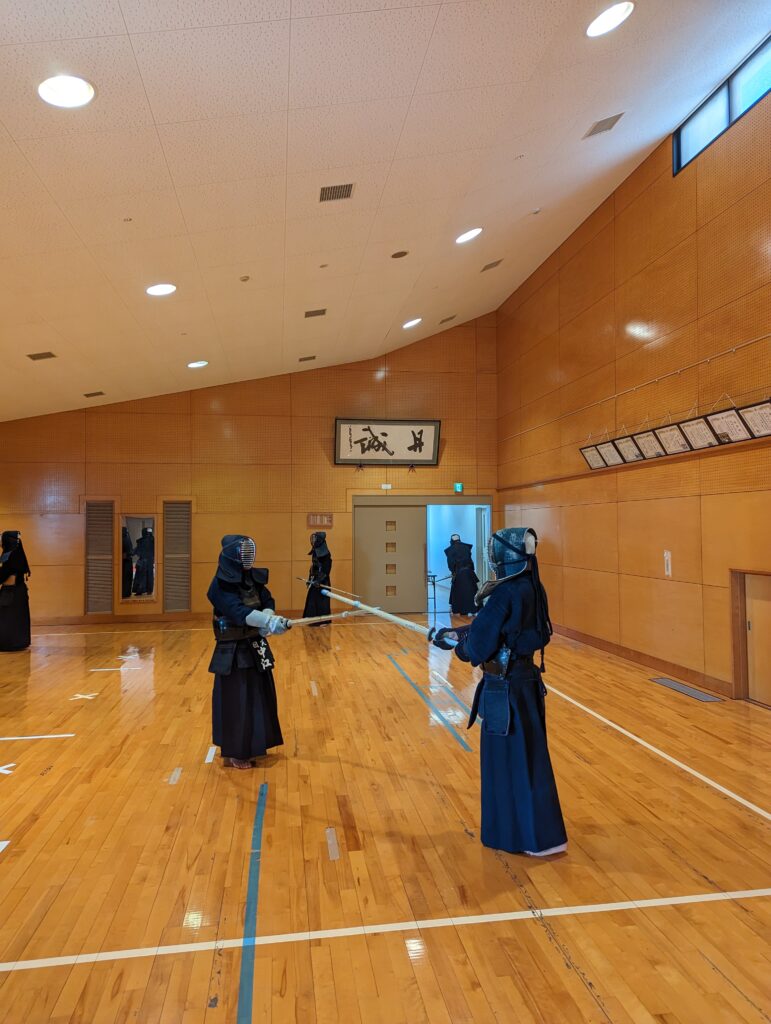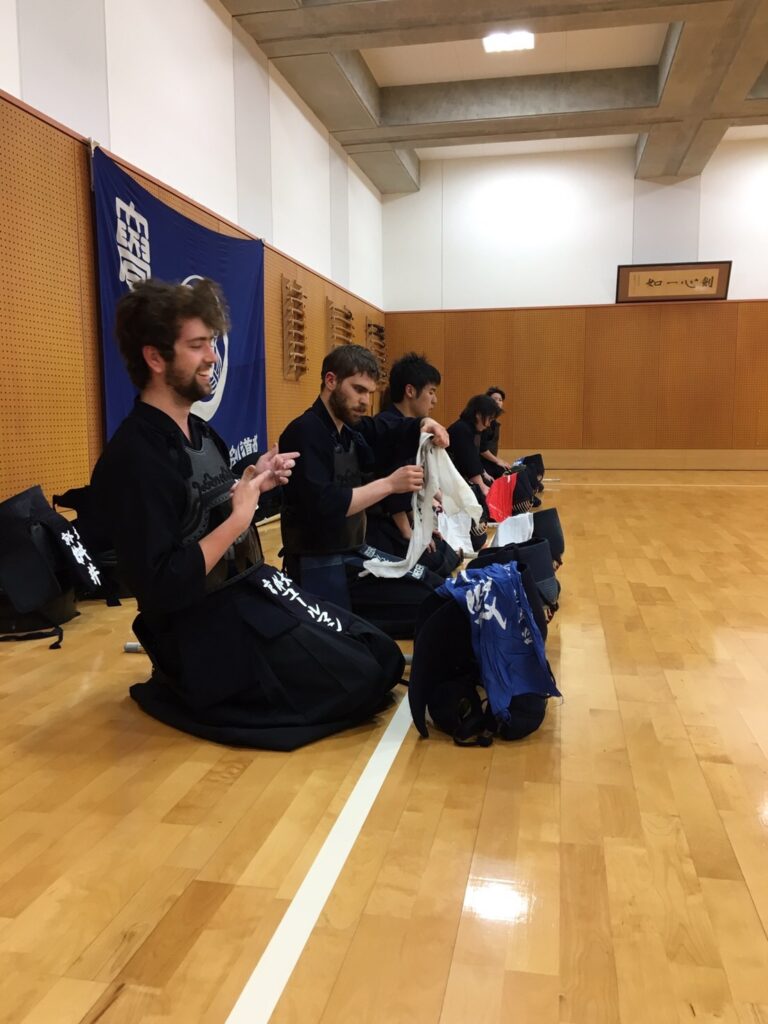This article originally appeared in the March 2023 issue of CONNECT.
Thomas Coleman (Hyogo)
Shrouded in blue armour masking their figures, the two swordsmen bow to each other and carefully press the hilt of their bamboo swords to their hips. They step one, two—swish—three, their weapons now drawn and the tips of their blades aiming at the other’s eye. Bending their knees, they sink to the floor, signifying the beginning of their historic ritual, before rising once again. Then, there’s a slight pause, the twitching of hands, the adjusting of feet, each swordsman glancing for a break in the other’s guard.
Kyaaaa! The warrior cries.
Hyuuaa! The warrior replies.
The tips of their blades start to hypnotically dance with each other as they poke and provoke their opponent. The swordsmen shadow each other’s movements, almost locked in symmetry. One swordsman slowly edges forward, sees his opening, and makes his move. In a single motion and with lightning precision, the warrior raises his sword and strikes his prey, whipping his weapon at his opponent’s head like a fisherman casting his line. Synchronous with his attack, the swordsman lets out a mighty roar—Meeeen!—as he springs himself forward off his left foot, bringing his lead foot thunderously down to the floor and pushing the strike through his opponent. Thwack. The battle truly begins.

The observer can’t help but ask: How could one not be enchanted by the etiquette, discipline, and skill of the kendoka? In a ritual that has been passed down through the centuries, who could not be captivated by the heirs of the samurai? These thoughts ignite an even deeper question: There is surely no way that I could learn to do all of that too . . . could I?
When watching these masters at work, it is easy to view Budo (Japanese martial arts) as an inaccessible world to beginners. In this scenario, you might block off any thought of trying it out for yourself. However, I argue that this would be a missed opportunity.
While I sat watching this intense kendo (Japanese-style fencing) match at my university in Kyoto in 2018, similar thoughts crossed my mind. I wondered how cool it would be to be one of the kendoka locked in this captivating duel. But not being the most athletic person nor a person with any particular affinity for combat sports, I at first dismissed these ideas. I would be a complete novice learning a complicated sport with only a basic level of Japanese. With this in mind, surely there would be little possibility of me actually becoming a kendoka. Yet the excitement of the match had already ignited a flare within me. What if I could learn kendo? The flare burned brighter until I couldn’t contain it any longer, and later that same day, I inquired about joining their dojo.
I quickly discovered that my worries were completely unfounded; the other students were exceptionally welcoming and gladly invited me to their sessions. Their commitment to their craft was infectious, and soon, I was attending as many practices as I could. Over the next year, they patiently trained me and even went so far as to lend me some gear so that I could fully share in their passion. The language barrier was also surprisingly no issue as what I didn’t understand in Japanese, they were able to demonstrate to me visually. At the same time, their friendliness and curiosity about me meant that I was able to increase my confidence when speaking Japanese too. Further, as a beginner, I was not expected to keep up with the rest and was able to learn at my own pace. Thus, the road to becoming a kendoka went from being an impossible fantasy to an achievable—albeit distant—target.

As I learnt more and more about kendo, the deep relationship between its history, practice,and ritual unexpectedly appealed to a different side of me: the humanities student. In every aspect of kendo, there is a callback to Japan’s long history of distinguished swordsmen.
From the very start, as you get dressed for practice, you change into the traditional uniform of the kendoka, the dogi (long-sleeved jacket) and hakama (long-loose trousers which resemble a skirt). When you start your warm-up, you reach for your bokuto (wooden sword), which has been used in dojo since at least the 1300s. Before you begin the main body of training, you will strap on your bogu (practice armour), the earliest designs of which were invented in sword schools during the 1700s. After this is securely fastened, you will pick up your shinai (bamboo sword), a weapon carefully designed by Edo period samurai to prevent injury to their sparring partners. Then, when you are ready to start, you will line up and perform several inherited rites such as sitting on your knees in seiza and bowing to both your instructors and the kami-sama (gods) of the dojo.
Finally, draped in the robes and rituals of history, you are ready to begin.
In kendo, there are four points of contact, all of which will be the subject of keiko (practice): men (helmet), kote (bracer), do (breastplate), and tsuki (throat guard). The drilling of these strikes is then implemented in shiai (matches), where, to score points, you must properly execute a strike to a point of contact, let out a kiai (shout), stamp your foot on the ground in an action called a furikomi[, and cleanly finish your technique. One of the other main activities is kata (choreographed patterns performed without armour and using bokuto). What is so interesting about these variations of practice is that the techniques can differ depending on the school, leaving a wide field to study and master. This means that even the most skilled kendoka have something to learn from a peer from another school.

After a couple of years of being involved with kendo, I have found that my initial flare has only grown stronger as the sport continues to provide me with exciting new opportunities. More recently, it has meant that I have been able to build a deeper connection with my local community in Himeji, an important part of working as an ALT. Introduced through a teacher at my school, I now attend a dojo located in eastern Himeji and only a short train ride from my apartment. Eagerly hopping off onto the platform every weekend, I head to practice knowing that, just as I had realised when I started my journey, there will always be something new to learn and more special moments to engage with.

Once I arrive, I bow, hurriedly enter the dojo, and quickly get changed into my dogi and hakama as I get ready for the session. Looking around the room, there is a vast array of people of all generations and abilities gathered. The practitioners range from older, highly ranked masters to younger, less-experienced students (including teenagers and children). Lastly, the glue of the group is the parents who help organise the twice-a-week meet and support everyone from the sidelines. Together, they form a locally renowned kendo association called Shirasagi Kenyukai (Shirasagi Friends of Kendo Association). In the dojo, there is a great sense of harmony and space for everyone, as the master and veteran kendoka passionately share their expertise with peers and impart their wisdom to the younger members. In this community, I have found my own space too. Here, I have been able to train with many skilled swordsmen and have learnt so much. The abundance of talented kendoka means that all levels of learners can have specific training before we all come together for a general practice. Moreover, this school is unique for Kanshin-ryu, a rare style of kendo originating in Tokushima in the 1500s. Thus, when I line up to begin our session, I know that I have become both a small stone in the pillar of the community and involved in keeping their important traditions alive.

What my experiences have taught me is this: If the opportunity to get involved in something new sparks your interest, don’t ignore it, don’t hesitate, just go for it. Whether it is martial arts or anything else, if nurtured, new experiences will not only provide you with new interests and a host of new and unexpected skill sets, but they will also give you a greater insight into yourself, your local community, and their customs.
Looking at Budo specifically, if kendo is not for you, then you can also choose from the many variants of Japanese martial arts that are widely practised throughout Japan and the world. While sports like karate and judo are globally popular, there are even more particular arts including aikido (the way of harmony and energy), Iaido (the way of sword drawing and swift defence), and kyudo (the way of archery) too.
So, when you are next inspired to do something, don’t question your ability to do it. Ask yourself instead: “When can I start?”

Thomas Coleman is a British ALT for the JET Programme currently working for two high schools in Himeji. As a humanities graduate, he has a keen interest in history and culture and can often be found travelling around historical sites with a book in hand. When he is not doing this, he will be at his local dojo practising kendo.



![CONNECT ART ISSUE 2024 SUBMISSIONS [CLOSED]](http://connect.ajet.net/wp-content/uploads/2024/04/ARTISSUE-INSTA-600x500.png)





